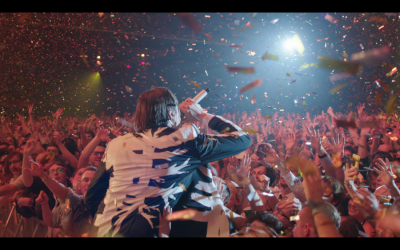The Reflektor Tapes
Plays Nov. 5 to 7 at Cinematheque
At one point in The Reflektor Tapes, the new documentary focusing on Arcade Fire’s most recent album and the surrounding tour, one of the band members muses offscreen, “Sometimes storytelling is more important than the melody. Sometimes it’s more important than the music.”
It’s a quote that I wish director Kahlil Joseph had paid more attention to. The Reflektor Tapes acts more as a visual companion to the record, giving little insight into its writing or recording.
The few interviews given are presented as offscreen narration, so even huge Arcade Fire fans will have difficulty identifying the voices they don’t recognize as lead vocalists Win Butler and Régine Chassagne.
The narration itself is sparse and disconnected from the onscreen action, which floats along with a stream-of-consciousness approach.
That’s not to say the film isn’t entertaining. In fact, any Arcade Fire fan will enjoy it. The editing and sound design are highly experimental, and it’s interesting to hear songs from across the band’s career dissected and reassembled along with impressionistic visuals.
But it would feel a lot more novel if the band hadn’t already done the same thing with Miroir noir, the nearly identical 2008 documentary by Vincent Morisset that accompanied their album Neon Bible.
The segments of the film focusing on Haiti are by far the most interesting. The band has talked extensively about how their experience in the Caribbean nation following the devastating 2010 earthquake influenced Reflektor.
Their collaborations with Haitian percussionists are the closest the film gets to capturing the band’s creative spark. Chassagne’s interviews discussing her cultural experiences as a Haitian-Canadian woman passing as white are vulnerable and touching. There are many incredible images of the Haitian Carnaval that would be fascinating in any film.
But one can’t help wishing for more from a documentary focusing on such an acclaimed album and the visually inventive tour that followed it. The album’s producer (and former LCD Soundsystem frontman) James Murphy has his sonic fingerprints all over many of the album’s songs, but he’s almost completely absent from the film.
Prominent lyrical and thematic influences, like the Marcel Camus 1959 film Black Orpheus, the Greek Orphic myth that inspired it, and the writings of Søren Kierkegaard, are swept under the rug in favour of Joseph’s abstract approach.
Perhaps it’s unfair to judge the film for what it isn’t. As a formal exercise presenting impressionistic fragments of Arcade Fire’s Reflektor era, it’s entirely competent.
The band’s exhilarating and energetic live shows are on full display, even if we rarely see an entire song performed. Like Miroir noir, the film gives many glimpses of unreleased songs and B-sides, providing a peek into the richer world beneath the album’s 13 songs, and surely sending many fans on deep-dive searches for these hidden gems.
But, despite all that, the ultimate disappointment of The Reflektor Tapes is that it feels too familiar. While Reflektor felt like new sonic territory for Arcade Fire, abandoning their baroque pop for Haitian beats and pulsating electronics, this film feels like a retread of their previous documentary outing.
Maybe it’s just Arcade Fire’s style to leave you wanting more. But, still, I wanted more.
Published in Volume 70, Number 9 of The Uniter (November 5, 2015)







